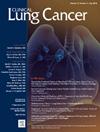Use of Oncogene Overlap by Tissue-Based Next-Generation Sequencing to Explore the Mutational Landscape and Survival Impact of HER2, KRAS and MET Copy-Number Gain in Nonsmall Cell Lung Cancer
IF 3.3
3区 医学
Q2 ONCOLOGY
引用次数: 0
Abstract
Background
Gene copy number gain (CNG) is a continuous variable. The relevant cutpoint for HER2, KRAS and MET CNG in non-mall cell lung cancer remains uncertain. As de novo driver oncogenes are largely mutually exclusive, oncogene overlap analysis can be used to explore CNG thresholds.
Patient and Methods
We retrospectively analysed NGS of DNA/RNA in 13,702 NSCLC adenocarcinoma samples. Alternate and same-gene driver oncogene co-occurrence with HER2, KRAS and MET CNG was examined. Overall survival (OS) from time of biopsy collection was correlated with CNG and pathogenic mutations in driver oncogenes (Driver+).
Results
The frequency of Driver+ tumors decreased with increasing CNG. Setting CNG thresholds by oncogene overlap and dataset size (CNA ≥ 6 for HER2, KRAS and ≥ 4 for MET), tumors considered relevantly amplified (Amp) for MET, HER2 and KRAS were significantly less likely to be Driver+ (P < .001). When Driver+ did overlap with Amp status, same-gene alterations (mutation and CNG) were significantly enriched for all 3 genes (HER2, KRAS and MET), while BRAF and EGFR mutations were more common in MET-Amp than in HER2- or KRAS-Amp tumors. A negative OS association with Amp status was independent of Driver+ status for HER2 and MET, however not KRAS.
Conclusion
Tissue NGS-based HER2, KRAS and MET CNG thresholds set by oncogene overlap identified potentially clinically relevant “Amp” subgroups with altered genetic profiles and decreased survival. Prospective research into targeted therapy benefit in these groups is encouraged.
通过基于组织的新一代测序技术利用肿瘤基因重叠探索非小细胞肺癌中HER2、KRAS和MET拷贝数增殖的突变情况和对生存的影响。
背景:基因拷贝数增殖(CNG)是一个连续变量:基因拷贝数增殖(CNG)是一个连续变量。非小细胞肺癌中 HER2、KRAS 和 MET CNG 的相关切点仍不确定。由于新的驱动癌基因在很大程度上是相互排斥的,因此可以利用癌基因重叠分析来探索 CNG 临界点:我们回顾性地分析了13702份NSCLC腺癌样本中DNA/RNA的NGS。研究了HER2、KRAS和MET CNG的替代基因和同基因驱动癌基因共存情况。从活检采集时算起的总生存期(OS)与CNG和驱动癌基因的致病突变(Driver+)相关:结果:Driver+肿瘤的发生率随着CNG的增加而降低。根据癌基因重叠和数据集大小设定CNG阈值(HER2和KRAS的CNA≥6,MET的CNA≥4),MET、HER2和KRAS相关扩增(Amp)的肿瘤被认为是Driver+的可能性显著降低(P < .001)。当Driver+与Amp状态重叠时,同基因改变(突变和CNG)在所有3个基因(HER2、KRAS和MET)中都明显富集,而BRAF和表皮生长因子受体突变在MET-Amp肿瘤中比在HER2-或KRAS-Amp肿瘤中更常见。OS与Amp状态的负相关与HER2和MET的Driver+状态无关,但与KRAS无关:结论:基于组织 NGS 的 HER2、KRAS 和 MET CNG 阈值由癌基因重叠度设定,确定了具有潜在临床相关性的 "Amp "亚群,这些亚群的基因图谱发生改变,生存率降低。我们鼓励对这些群体的靶向治疗获益进行前瞻性研究。
本文章由计算机程序翻译,如有差异,请以英文原文为准。
求助全文
约1分钟内获得全文
求助全文
来源期刊

Clinical lung cancer
医学-肿瘤学
CiteScore
7.00
自引率
2.80%
发文量
159
审稿时长
24 days
期刊介绍:
Clinical Lung Cancer is a peer-reviewed bimonthly journal that publishes original articles describing various aspects of clinical and translational research of lung cancer. Clinical Lung Cancer is devoted to articles on detection, diagnosis, prevention, and treatment of lung cancer. The main emphasis is on recent scientific developments in all areas related to lung cancer. Specific areas of interest include clinical research and mechanistic approaches; drug sensitivity and resistance; gene and antisense therapy; pathology, markers, and prognostic indicators; chemoprevention strategies; multimodality therapy; and integration of various approaches.
 求助内容:
求助内容: 应助结果提醒方式:
应助结果提醒方式:


